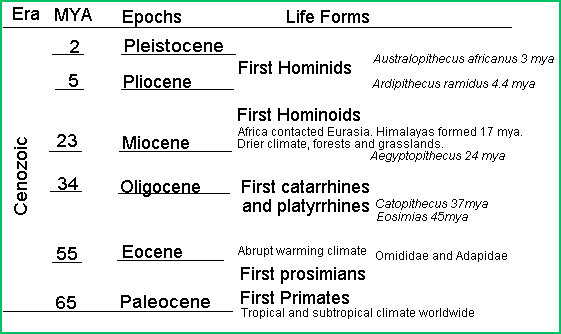Periods of Primate Evolution and their Fossils

Most people like to trace their ancestry.
I have heard some people say that they can trace their ancestry back several centuries, usually to some nobleman or famous historical figure. I can trace my ancestry back 50 million years, but as luck would have it he was a skinny little guy that lived in trees and ate insects. Oh well... The far right column in the chart indicates the name of a relative for whom actual fossils have been dated.
The Players
The first primates came on stage shortly after the dinosaurs. Primates is the taxonomic Order which comprises all lemurs, tarsiers, monkeys, apes, humans and similar forms. Prosimians (Prosimii) is a suborder of primates such as tarsiers, lemurs, and lorises. Omididae is an extinct family of tarsier-like primates and Adapidae is an extinct family of lemur-like primates. Modern lorises and lemurs are their likely descendents. Catarrhines (literally "hook-nosed") refers to Old world (African and Asian) monkeys and their descendents including higher apes and hominids with closely spaced nostrils and no prehensile tails. Platyrrhines ("broad-nosed) refers to the New World (mostly South American) monkeys with broad noses and frequently prehensile tails.
I compiled this chart from information presented in a widely used introductory anthropology text book, (Haviland,William A. 2000. Anthropology, 9th Ed. Harcourt College Publishers, Fort Worth ,Texas). Most of the information can be found in Chapters 4, 5 and 6, on primates, fossil primates and early hominines respectively.